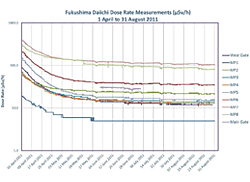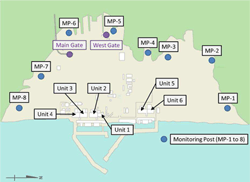- Home >
- Pertinent information concerning the Fukushima Dai-ichi NPS accident >
- Toward accident convergence and decommissioning >
- Brief description of operations 1
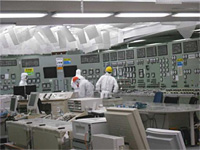
Control room of Unit 2
In the Fukushima Dai-ichi NPS, the work for an early emergency response, reactor core cooling stabilization and subsequent restoration were performed. Since the environment in these work had the high dose rate and the high contamination of radioactive materials, measures for exposure reduction, such as maintenance of work environment or protective equipment, decontamination and removal of rubble, and mechanization of work, were taken for a worker's radiological protection.
Protective equipment appropriate to the work environment is provided to workers in order to improve safety during radiation related work, such as air filtering personal protection suits and masks. Moreover, the mask with a blower, cooling vest and the refrigerant for necks etc. were used as a measure against heatstroke in summer.
 An example of wearing a cooling scarf
An example of wearing a cooling scarf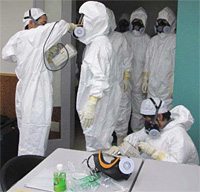 Training of radiation workers
Training of radiation workersSome rest stations were installed in the site, and also the emergency medical rooms were established and emergency specialist who is familiar with radiation medical treatment was in charge of medical examination.
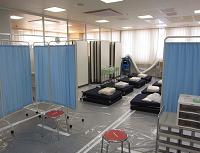 Emergency medical room
Emergency medical room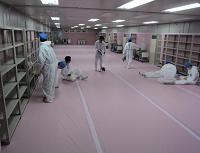 Example of rest area
Example of rest areaThe large-scale release of radioactive materials and the reactor building explosions led to contamination inside the seismic isolated building at which many workers engaged in recovery work were staying. Therefore, countermeasures for exposure reduction such as setting up localized exhaust fans with charcoal filters, erecting a temporary house at the entrance to prevent carrying in contamination were implemented.
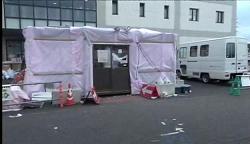
Seismic isolated building entrance (unit house for in-and-out management)
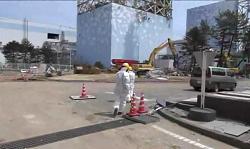 Unmanned heavy machinery by remote control
Unmanned heavy machinery by remote controlThe large-scale release of radioactive materials and the reactor building explosions led to high dose rate and contamination by radioactive materials of the entire site, which became an obstacle when performing the accident control actions and recovery work. In the removal work of outdoor high dose debris, unmanned heavy machinery by remote control was utilized, and exposure reduction was achieved.
Radiation monitoring of dose rates and airborne contamination is performed continuously.On-site measurements of airborne contamination have been taken by an air sampler inside a vehicle.
Survey map of Fukushima Dai-ichi NPS >>
Map of dose rate measurement points and dose rate (µSv/h) at Fukushima Dai-ichi NPS.
Since the inside of the reactor building had many zones where a dose rate is very high, radiation dosimetry by a robot was carried out in order to advance recovery work. Robots such as Quince, Packbot, Survey Runner, Talon and Bobcat were used.
 Packbot
Packbot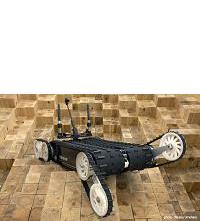 Quince
Quince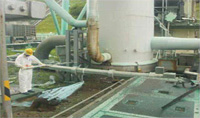 Measurement near the SGTS pipe joint at the bottom of the main exhaust stack of Units 1 and 2
Measurement near the SGTS pipe joint at the bottom of the main exhaust stack of Units 1 and 2At the beginning of August, 2011 some localized very high radiation fields were identified. The dose rate near the standby gas treatment system pipe joint at the bottom of the main exhaust stack of Units 1 and 2 was 10 or more Sv/h. The dose rate around the entrance to the Train Room for the Standby Gas Treatment System on the second floor of the turbine building of Unit 1 was estimated to be greater than 5 Sv/h.
The accumulated water in the trench of the turbine building o fUnits 2 and 3 etc. was transferred to the concentrated radwaste buildings. TEPCO installed cesium adsorption/decontamination facilities and desalination processing facilities and processed contaminated water. The tank for treated water receptacles for keeping the processed accumulated water was also installed one by one.
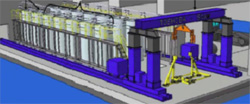 Cesium removal system-SARRY
Cesium removal system-SARRY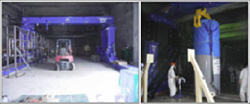 SARRY installation work
SARRY installation workMulti-nuclide removal equipment was installed to further reduce the densities of the radioactive materials included in the accumulated water in the power station site.
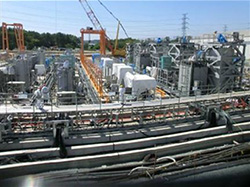 Installation of multi-nuclide removal equipment
Installation of multi-nuclide removal equipment- TEPCO Road Map
- Brief description of operations 1
- Brief description of operations 2


